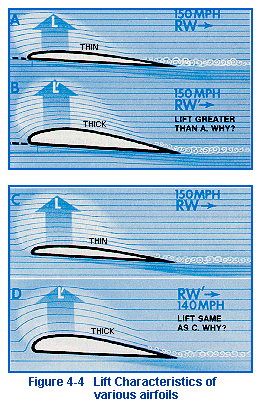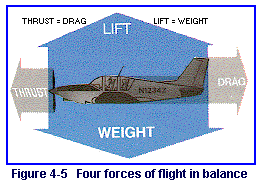 |
|||||
| Home | Research | For Teachers | HISTORY Level 1 Level 2 Level 3 |
PRINCIPLES Level 1 Level 2 Level 3 |
CAREER Level 1 Level 2 Level 3 |
| Gallery | Hot Links | What's New! | |||
| Web Administration and Tools | |||||
 |
|||||
| Home | Research | For Teachers | HISTORY Level 1 Level 2 Level 3 |
PRINCIPLES Level 1 Level 2 Level 3 |
CAREER Level 1 Level 2 Level 3 |
| Gallery | Hot Links | What's New! | |||
| Web Administration and Tools | |||||
![]()
The energy factors at the upper surface of a wing, as we have said,
are velocity and pressure—higher velocity, lower pressure. If the velocity of the
relative wind is normally very high during  cruising flight of an airplane, it is not necessary for its wings to have much
camber. This is one of the reasons why fighter-type military aircraft have thin wings. At
slower speeds, such as during takeoffs or landings, the loss of induced lift because of
the low camber is compensated for by using a high angle of attack. As you can see, this
high angle of attack causes an increase in the dynamic lift. Even so, the airplane with
low-camber airfoils must use much higher takeoff and landing speeds than the more
conventional airplane.
cruising flight of an airplane, it is not necessary for its wings to have much
camber. This is one of the reasons why fighter-type military aircraft have thin wings. At
slower speeds, such as during takeoffs or landings, the loss of induced lift because of
the low camber is compensated for by using a high angle of attack. As you can see, this
high angle of attack causes an increase in the dynamic lift. Even so, the airplane with
low-camber airfoils must use much higher takeoff and landing speeds than the more
conventional airplane.
To further illustrate these points, note in the top portion of Figure 4-4 that we have two examples of airfoils with the same relative wind velocity and the same dynamic lift. However, by thickening and increasing the camber of the wing, wing B's total lift is increased because of the increased induced lift.
In the lower portion of Figure 4-4, you are looking at two wings which are producing the same mount of total lift even though one wing has less amber than the other. Both wings are at the same angle of attack so they have the same amount of dynamic lift for any given airspeed (velocity of the relative wind). The only way to make the thin wing produce as much lift as the thick wing is to speed it up, and this is what we attempt to show in the figure. Wing C's relative wind is ten miles per hour faster than D's relative wind, this additional speed is needed to increase both the dynamic and induced lift so that its total lift can equal that of Wing D. We want you to understand that the examples in Figure 4-4 are just that.
We have discussed the atmosphere and how airfoils produce lift
because of their movement through the atmosphere. We also mentioned that lift is the force
that counteracts the force of  gravity
to allow flight. At this point, you may have concluded that lift and gravity are the only
forces involved with flight. Actually there are two others, thrust and drag, which
complete the three-dimensional forces acting upon an aircraft in flight. Figure 4-5 shows
the basic directions of all four forces when an aircraft is in straight and level flight
at a constant speed. Now, you should be able to see that, in this situation, the four
forces are in balance. The force of total lift equals the force of total weight, so there
is no upward or downward movement. The force of thrust equals the force of drag, so there
is no increase or decrease in the speed of the airplane. You should also be able to see
that the moment one of these forces becomes stronger or weaker than the others, some type
of reaction must take place.
gravity
to allow flight. At this point, you may have concluded that lift and gravity are the only
forces involved with flight. Actually there are two others, thrust and drag, which
complete the three-dimensional forces acting upon an aircraft in flight. Figure 4-5 shows
the basic directions of all four forces when an aircraft is in straight and level flight
at a constant speed. Now, you should be able to see that, in this situation, the four
forces are in balance. The force of total lift equals the force of total weight, so there
is no upward or downward movement. The force of thrust equals the force of drag, so there
is no increase or decrease in the speed of the airplane. You should also be able to see
that the moment one of these forces becomes stronger or weaker than the others, some type
of reaction must take place.
Send all comments to ![]() aeromaster@eng.fiu.edu
aeromaster@eng.fiu.edu
© 1995-98 ALLSTAR Network. All rights reserved worldwide.
| Funded in part by | From Civil Air Patrol Educational Materials |
Updated: February 23, 1999